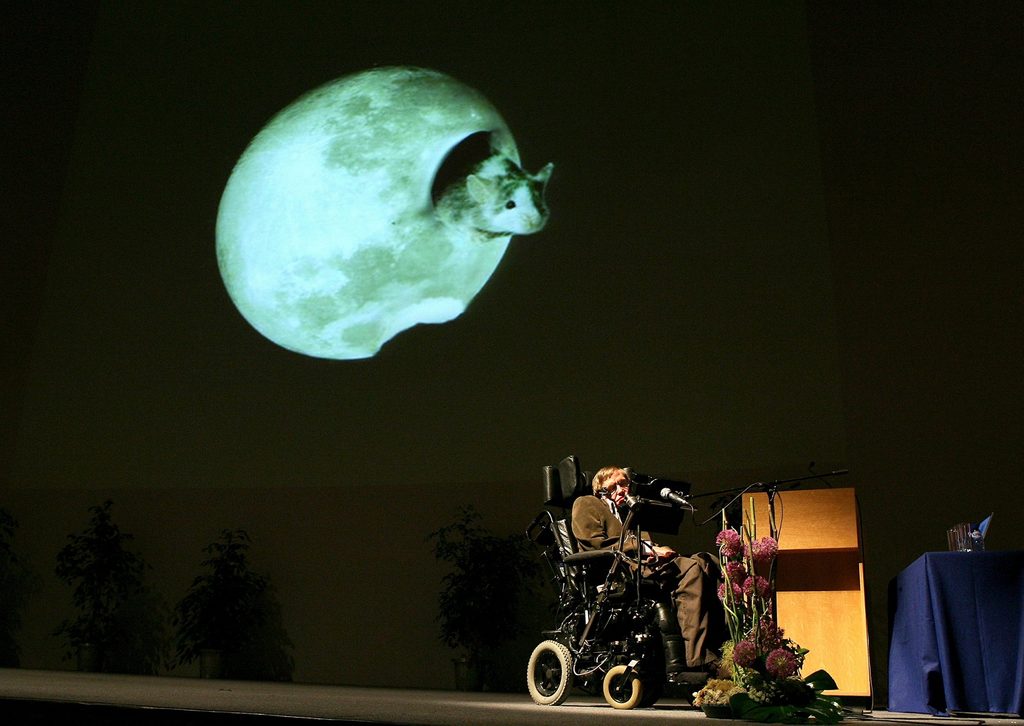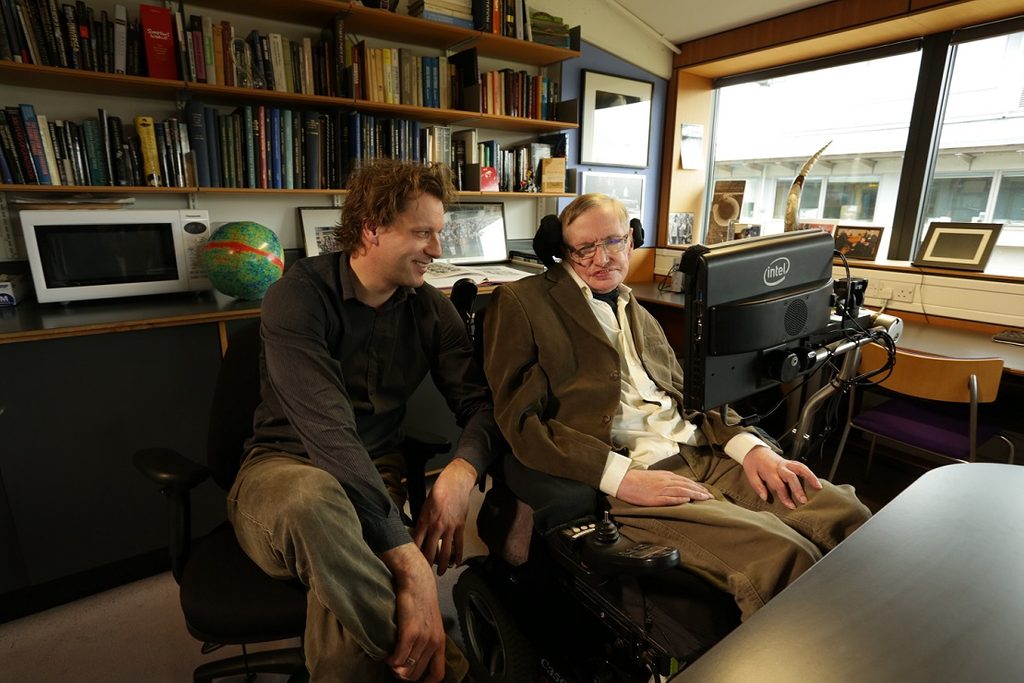The door to Stephen Hawking’s office was olive green and though it was near the bustling common room, he liked it to be slightly open. I knocked and entered, feeling as though I’d been transported into a timeless world of contemplation.
I found Stephen sitting quietly behind his desk, facing the entrance, with his head, too heavy to hold straight, leaning against a headrest on his wheelchair.
He slowly raised his eyes and greeted me with a welcoming smile, as if he had been expecting me all along. His nurse offered me a seat next to him and I glanced at the computer on his desk. A screen saver scrolled perpetually across the screen: To boldly go where Star Trek fears to tread.
Stephen Hawking is widely seen as the world’s greatest theoretical physicist of the past half-century, with a genius status akin to Albert Einstein’s. Paralysed for much of his life through motor neuron disease, he nonetheless wrote the bestselling book ‘A Brief History of Time’ and produced extraordinary scientific insights right until he died in 2018, aged 76.
But this was our first meeting. It was mid-June of 1998, and I had just received my master’s degree in physics at KU Leuven (or Katholieke Universiteit Leuven). Now I was in Cambridge University’s labyrinthine Department of Applied Mathematics and Theoretical Physics (DAMTP), in a creaking Victorian building on the Old Press site on the banks of the river Cam.
For nearly three decades, this had been Stephen’s base camp, the nexus of his scientific endeavours. It was here that, despite being wheelchair-bound and unable to lift even a finger, he had passionately strived to bend the cosmos to his will.
A soft clicking broke the silence. Stephen had started talking. Having lost his natural voice in a tracheotomy following a bout of pneumonia more than a decade before, he now communicated through a disembodied computer voice. It was a slow, laborious process.
Mustering the last bit of force in his atrophied muscles, he exerted a feeble pressure on a clicking device, much like a computer mouse, which directed a cursor on the screen fitted to an arm of his wheelchair. He appeared to navigate the electronic dictionary instinctively, pressing the clicker rhythmically as if it were dancing to his brain waves. A minute or three later, Stephen directed the cursor to the icon ‘Speak’ in the upper left corner of the screen and said, in his electronic voice, “The universe appears designed. Why is it the way it is?”

Stephen Hawking at a public lecture in Brussels on 'The Origin of the Universe'
This was the fateful question that would keep us occupied for 20 years. What started as a doctoral project evolved into an intense collaboration that ended only with his passing on March 14, 2018 (a date redolent in mathematic symbolism: not only is it known as Pi Day, for the 3.14 formatting, but it is also Einstein’s birthday).
Big Bang Theory
The enigma at the heart of our research was how the Big Bang could have created conditions so perfectly hospitable to life. Profound questions about our ultimate origins take physics out of its comfort zone, yet this was exactly where Hawking liked to venture. The prospect — or hope — of cracking the riddle of cosmic design drove much of Hawking’s research in cosmology.
Our shared scientific quest inevitably drew us close. Being around Stephen, one could not fail to be influenced by his determination and optimism that we could tackle these mystifying questions. He made me feel as if we were writing our own creation story, which, in a sense, we did.
Our ancestors believed that the apparent design of the cosmos meant there had to be a designer, a God. Today, scientists point to the laws of physics. These laws have several striking life-engendering properties.
Take the amount of matter and energy in the universe, the delicate ratios of the forces or the number of spatial dimensions. Physicists have discovered that if you tweak these properties ever so slightly, it renders the universe lifeless. It almost feels as if the universe is a fix – a big one.
So where do the laws of physics come from? From Einstein to early Hawking, most 20th century physicists saw the mathematical relationships that underlie the laws of physics as eternal truths. In this view, the apparent design of the cosmos is a matter of mathematical necessity. The universe is the way it is because nature had no choice.
Around the turn of the millennium, a different explanation emerged. Perhaps we live in a multiverse, an enormous space that spawns a variegated patchwork of universes, each with its own kind of Big Bang and physical laws. It would make sense, statistically, for a few of these universes to be life-friendly.
However, these unverifiable multiverse musings soon stumbled into a spiral of paradoxes.
Could we do better? Stephen and I believed that we could. But it was only by relinquishing the idea, inherent in modern cosmology, that our physical theories can take a God’s eye view, as if somehow standing outside the entire cosmos.

In Hawking's Cambridge office
This is an obvious and seemingly tautological point: cosmological theory must account for the fact that we exist within the universe. “We are not angels who view the universe from the outside,” Stephen told me. "Our theories are never decoupled from us."
The universe inside-out
We set out to rethink cosmology from an inside-out perspective. It required adopting the strange rules of quantum mechanics, the theory which governs the microworld of particles and atoms.
Quantum mechanics says that particles can be in several locations at the same time – a property called superposition. It is only when a particle is observed that it (randomly) picks a definite position. Quantum mechanics also involves random jumps and fluctuations, such as particles popping out of empty space and disappearing again. In a quantum universe, therefore, a tangible past and future emerge out of a haze of possibilities through a continual process of observing.
Of course, such quantum observations don't need to be carried out by humans. And the environment or even a single particle can ‘observe’. Countless such quantum acts of observation constantly transform what might be into what does happen – thereby drawing the universe more firmly into existence. And once something has been observed, all other possibilities become irrelevant.
Back in the 1930s, Belgian priest-astronomer Georges Lemaître was the first to suggest that quantum ideas would be important to describe what happened at the big bang. Stephen and I did just that. When we look back at the earliest stages of the universe through a quantum lens, we uncover a deeper level of evolution, in which even the laws of physics change and evolve, in sync with the emerging universe.
This meta-evolution has a Darwinian flavour. Variation enters because random quantum jumps cause frequent small excursions from deterministic behaviour and occasional larger ones. Selection enters because some of these excursions can be amplified and frozen, thanks to quantum observation. The interplay between these two competing forces – variation and selection – in the primaeval universe produces a branching tree of physical laws.
The upshot of this research is a profound revision of the fundamentals of cosmology. Until now, cosmologists assumed initial conditions that existed at the time of the Big Bang and then considered how today’s universe evolved from them.
But we found that what we thought were ‘initial conditions’ are themselves the result of evolution. Dimensions, forces, and particle species transmute and diversify in the furnace of the hot Big Bang, somewhat analogous to how biological species emerge billions of years later.
They acquire their effective form only as the universe expands and cools. Moreover, the randomness involved means that the outcome of this evolution – the specific set of physical laws that makes our universe what it is – can only be understood ex-post facto, or in retrospect.

Hertog delivering his own lecture
One could say that the early universe was a superposition of an enormous number of possible worlds. But we are looking at the universe at a time when humans, galaxies and planets exist. That means we see the history that led to our evolution. We observe parameters with lucky values. However, we are wrong to assume they were somehow designed to be like that.
The crux of our hypothesis is that by reasoning backwards in time, there is an evolution towards more simplicity and less structure. Ultimately, even time fades away and, with it, physical laws.
Cosmos as a hologram
This view is borne out by the holographic form of our theory in which time and causality are seen as emergent qualities of the universe. The latest cosmos-as-hologram ideas radiate the view that time doesn't enjoy a prior existence but arises from the interactions between countless quantum particles (qubits).
It is a bit like how temperature emerges from the collective motion of many atoms. One ventures back in time by zooming out and taking a fuzzier look at the hologram. Eventually, however, one runs out of information. This would be the origin of time, the Big Bang.
For almost a century, we have studied the origin of the universe against the stable background of immutable laws of nature. But our theory reads the universe’s history from within and as one that includes, in its earliest stages, the genealogy of the physical laws. It isn't the laws as such but their capacity to transmute that has the final word.
In many ways, this bridges the conceptual chasm that for eons has separated biology and physics. Metaphorically, one might say that a quantum outlook on cosmology shows how the broad principles of Darwinism, that quintessential biological scheme, reach down into the deepest level of cosmological evolution.
Such an extraordinary arc reveals a profound unity in nature. It is indeed proper that Stephen Hawking’s ashes are buried in between the graves of Charles Darwin and Isaac Newton in the nave of Westminster Abbey. Future cosmological observations may find distinct fossil relics of this most ancient layer of evolution.
Precision observations of gravitational waves, for instance, may reveal signatures of some of the branching of the early universe. If spotted, Stephen’s cosmological finale may well prove to be his greatest scientific legacy.

